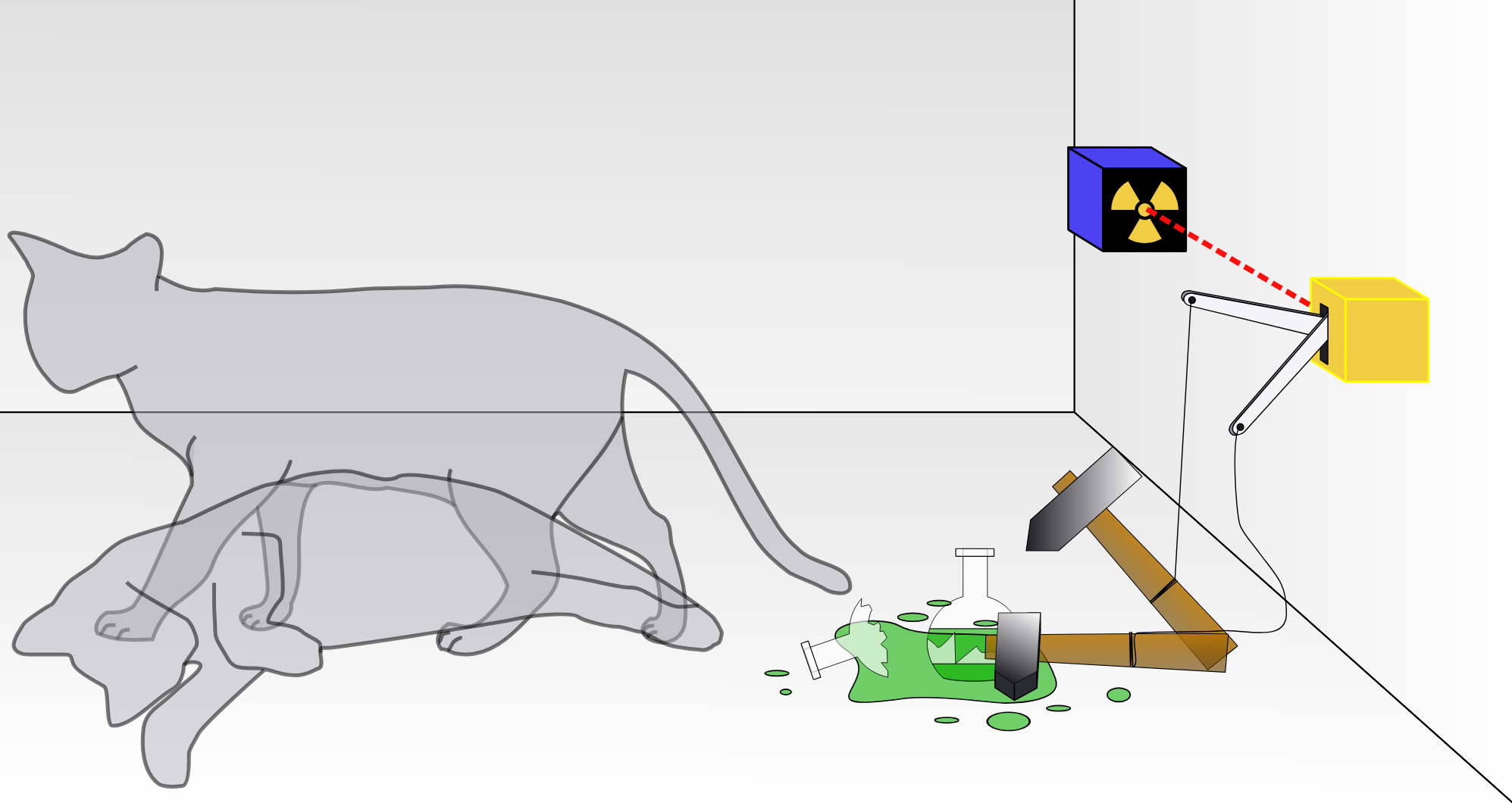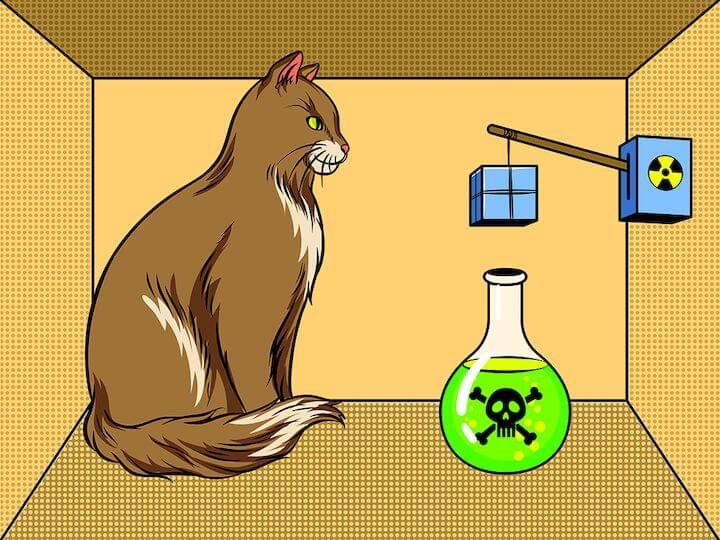How Does Schrödinger's Cat Challenge Reality?
Schrödinger’s cat is a thought experiment proposed by Erwin Schrödinger in 1935 to illustrate the seemingly absurd consequences of applying quantum mechanics to macroscopic objects. The scenario involves a sealed box containing a cat, a radioactive atom, a Geiger counter, and a vial of poison. If the atom decays, the Geiger counter will trigger the release of the poison, killing the cat. According to quantum mechanics, before measurement (i.e., opening the box), the system is in a superposition of states: both alive and dead at the same time.
The paradox arises because quantum mechanics predicts that the wave function describing the system collapses upon observation or measurement. This means that until the box is opened and the cat is observed, it exists in a state of being both alive and dead simultaneously. However, this leads to philosophical and practical questions about what happens during the period when the cat is not observed and how the act of observation itself affects the outcome.
The concept of superposition is central to quantum mechanics, where particles can exist in multiple states simultaneously until measured. In the case of Schrödinger’s cat, this implies that the cat could be in a state of both life and death at once until the box is opened and the state is “observed”. This thought experiment challenges our classical understanding of reality and has sparked extensive debate and research in the fields of physics and philosophy.
In summary, Schrödinger’s cat is a thought-provoking example that highlights the strange implications of applying quantum principles to macroscopic objects and raises important questions about the nature of reality and measurement.
What are the latest experimental evidences supporting or refuting Schrödinger’s cat paradox?
The latest experimental evidences supporting or refuting Schrödinger’s cat paradox are not directly provided in the search results. However, there are several pieces of evidence that discuss theoretical and conceptual advancements related to the paradox:
-
**** mentions a breakthrough by researchers from Yale University, who have developed a “quantum error-correcting cat” that combines the concept of superposition from Schrödinger’s cat with the ability to correct errors in fragile quantum bits during a task. This suggests an application of quantum mechanics principles similar to those in Schrödinger’s thought experiment.
-
**** discusses a re-investigation of Schrödinger’s cat paradox, distinguishing between superpositions of macroscopic cat states and entangled states involving both the cat and a radioactive substance. This indicates ongoing academic interest in clarifying the nature of superposition and entanglement in relation to the paradox.
-
**** presents a new perspective on resolving Schrödinger’s cat paradox, suggesting that it could lead to a harmonious coexistence between quantum mechanics and Einstein’s theory of relativity. This implies that recent theoretical work may be addressing the foundational issues raised by the paradox.
-
**** provides a description of Schrödinger’s cat within the Copenhagen interpretation, stating that the cat is both alive and dead until the box is opened, and that the wave function collapses upon observation. This is a classic explanation of the paradox, but it does not provide new experimental evidence.
-
**** critiques the thought experiment, arguing that it does not accurately reflect the situation where objects can exist in multiple states simultaneously according to quantum mechanics. It suggests that human intuition resists the idea of an object being in two states at once.

How has the concept of superposition in quantum mechanics evolved since its introduction by Erwin Schrödinger?
The concept of superposition in quantum mechanics, introduced by Erwin Schrödinger, has undergone significant evolution since its inception. Initially, Schrödinger formulated the wave function to explain the wave nature of particles, which is central to understanding superposition. Superposition allows a quantum system to exist in multiple states simultaneously, such as being both dead and alive in Schrödinger’s famous thought experiment involving a cat.
Over time, the implications of superposition have been expanded beyond single-particle systems to multiparticle interactions. This expansion revealed new phenomena that are richer and more complex than those observed in one-particle systems. For instance, entanglement, which Schrödinger described as a form of superposition in multiparticle systems, has become a fundamental aspect of quantum mechanics.
Further developments in the 1960s led to the formulation of Bell inequalities by John Bell, which could be experimentally verified to distinguish between classical and quantum behaviors based on the properties of superposition. These advancements underscored the importance of superposition not just as a theoretical construct but as a practical tool for testing the limits of quantum mechanics.

What philosophical implications does Schrödinger’s cat have on our understanding of reality and consciousness?
Schrödinger’s cat, a thought experiment proposed by Austrian physicist Erwin Schrödinger in 1935, has profound philosophical implications on our understanding of reality and consciousness. This experiment illustrates the strange nature of quantum mechanics, where an object can exist in multiple states simultaneously until observed.
The primary philosophical implication is the challenge to the concept of objective reality. According to quantum theory, as exemplified by Schrödinger’s cat, an object like a cat can be in a superposition of states (both dead and alive at the same time) until it is observed. This challenges the idea of an independent, objective reality that exists regardless of observation. Instead, it suggests that reality might be fundamentally observer-dependent.
This leads to discussions about the role of consciousness in shaping our perception of reality. The Copenhagen interpretation of quantum mechanics posits that until the act of measurement occurs, the system exists in a state of superposition. Only upon observation does the wave function collapse into one definite state. This raises questions about whether consciousness itself plays a role in this process, potentially influencing what we perceive as reality.
Furthermore, Schrödinger’s cat also touches upon issues related to free will and the nature of consciousness. It prompts thinking about whether our decisions and actions are truly free or if they are predetermined by underlying physical processes. Additionally, it explores how consciousness might interact with or influence quantum phenomena, leading to theories such as quantum consciousness, which propose that consciousness could be a quantum mechanical phenomenon itself.
In summary, Schrödinger’s cat underscores the complex relationship between consciousness and reality, highlighting the potential for consciousness to play a role in defining what we consider real.
Are there any practical applications of the principles behind Schrödinger’s cat in modern technology or research?
Yes, the principles behind Schrödinger’s cat have significant practical applications in modern technology and research. One of the most notable applications is in the field of quantum computing. Quantum computers leverage the concepts of superposition and entanglement, which are illustrated by Schrödinger’s thought experiment. These phenomena allow quantum computers to perform multiple operations simultaneously, making them potentially capable of solving problems that are practically impossible for classical computers due to the exponentially increasing disparity in the time required.
Additionally, quantum mechanics, which includes the principles demonstrated by Schrödinger’s cat, has led to the development of various technologies such as chips, lasers, atomic bombs, transistors, and nuclear magnetic resonance.
How do different interpretations of quantum mechanics address the issue of wave function collapse in systems like Schrödinger’s cat?
Different interpretations of quantum mechanics address the issue of wave function collapse in systems like Schrödinger’s cat in various ways:
-
Copenhagen Interpretation: This is one of the most widely discussed interpretations. According to this view, the wave function collapses upon measurement or observation. The act of observation itself causes the superposition of states to resolve into a single definite state. This interpretation suggests that the wave function does not evolve deterministically but rather collapses probabilistically when measured.
-
Many-Worlds Interpretation: In this interpretation, the wave function never collapses; instead, every possibility branches out into a new reality. Thus, in the context of Schrödinger’s cat, both alive and dead states would exist simultaneously in different branches of reality.
-
Quantum Bayesianism: This interpretation posits that the wave function represents an agent’s degree of belief about the state of a system. It does not collapse upon measurement but rather updates based on new information received from measurements.
-
Objective Collapse Theories: These theories propose that the wave function collapses spontaneously without any external measurement. They suggest that collapse can occur due to intrinsic properties of particles or environmental interactions.
-
Gravitational Interpretation: Some theories explore the possibility that gravity could induce wave function collapse, especially at macroscopic scales where gravitational effects become significant.
-
Thermodynamic Interpretation: According to some arguments, wave function collapse might be related to thermodynamic processes such as entropy increase within the system. However, this idea faces challenges as it contradicts the second law of thermodynamics in certain scenarios.
comments powered by Disqus